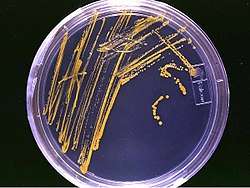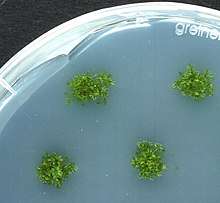Petri dish
A Petri dish (alternatively known as a Petri plate or cell-culture dish) is a shallow transparent lidded dish that biologists use to culture cells,[1][2] such as bacteria, fungi or small mosses.[3] It is the most common type of culture plate. The Petri dish is one of the most common items in biology laboratories and has entered popular culture. The term is often written in lower case, especially in non-technical literature.[4][5]


Penicillin, the first antibiotic, was discovered in 1929 when Alexander Fleming noticed that mold that had contaminated a bacterial culture in a Petri dish had killed the bacteria all around it.
The container is named after its inventor, the German bacteriologist Julius Richard Petri.[6][7]
Features and variants
Petri dishes are usually cylindrical, mostly with diameters ranging from 30 to 200 mm,[8][9] and a height to diameter ratio ranging from 1:10 to 1:4.[10] Squarish versions are also available.[11][12]
Petri dishes were traditionally meant to be reusable and made of glass; often of heat-resistant borosilicate glass for proper sterilization at 120–160 °C.[8]
Since the 2010s, plastic dishes, usually disposable, are also common.[13]
Petri dishes are often covered with a shallow transparent lid, resembling a slighly wider version of the dish itself. The lids of glass dishes are usually loose-fitting.[8] Plastic dishes may have close-fitting covers that retard drying of the contents.[14] Alternatively, some glass or plastic versions may have small holes around the rim, or ribs on the underside of the cover, to allow for ventilation of the air space over the culture and avoid water condensation that may be a problem that needs some attention.[15]
Some Petri dishes, especially plastic ones, usually feature rings and/or slots on their lids and bases so that they are less prone to sliding off one another when stacked.[14]
Small Petri dishes may have a protruding base that can be secured on a microscope stage for direct examination [16]
Petri dishes may have grids printed on the bottom to help in measuring the density of cultures.[17][11][12]
A multiwell plate is a single transparent container with an array of flat-bottomed cavities, each being essentially a small Petri dish. It makes it possible to inoculate and grow dozens or hundreds of independent cultures of dozens of samples at the same time. Besides being much cheaper and convenient than separate dishes, the multiwell plate is also more amenable to automated handling and inspection.
Uses
Microbiology

Petri dishes are widely used in biology to cultivate microorganisms such as bacteria, yeasts, and molds. It is most suited for organisms that thrive on a solid or semisolid surface.
The culture medium is often an agar plate, a layer a few mm thick of agar or agarose gel containing whatever nutrients the organism requires (such as blood, salts, carbohydrates, amino acids) and other desired ingredients (such as dyes, indicators, and medicinal drugs). The agar and other ingredients are dissolved in warm water and poured into the dish and left to cool down. Once the medium solidifies, a sample of the organism is inoculated ("plated").
The dishes are then left undisturbed for hours or days while the organism grows, possibly in an incubator. They are usually covered, or placed upside-down, to lessen the risk of contamination from airborne spores.
Virus or phage cultures require that a population of bacteria be grown in the dish first, which then becomes the culture medium for the viral inoculum.
While Petri dishes are widespread in microbiological research, smaller dishes tend to be used for large-scale studies in which growing cells in Petri dishes can be relatively expensive and labor-intensive.[18][19]
Contamination detection and mapping
Petri dishes can be used to visualize the location of contamination on surfaces, such as kitchen counters and utensils,[20] clothing, food preparation equipment, or animal and human skin[21] [22]
For this application, the Petri dishes may be filled so that the culture medium protrudes slightly above the edges of the dish to make it easier to take samples on hard objects. Shallow Petri dishes prepared in this way are called Replicate Organism Detection And Counting (RODAC) plates and are available commercially.[23][24]
Cell culture
Petri dishes are also used for cell cultivation of isolated cells from eukaryotic organisms, such as in immunodiffusion studies, on solid agar or in a liquid medium. In the latter, the cells often grow as a layer attached to the bottom surface of the dish, below the culture medium.[25]
Botany and agriculture

Petri dishes may be used to observe the early stages of plant germination, and to grow plants asexually from isolated cells.
Entomology
Petri dishes may be convenient enclosures to study the behavior of insects and other small animals.
Chemistry
Due to their large open surface, Petri dishes are effective containers to evaporate solvents and dry out precipitates, either at room temperature or in ovens and desiccators.
Sample storage and display
Petri dishes also make convenient temporary storage for samples, especially liquid, granular, or powdered ones, and small objects such as insects or seeds. Their transparency and flat profile allows the contents to be inspected with the naked eye, magnifying glass, or low-power microscope without removing the lid.
In popular culture
The Petri dish is one of a small number of laboratory equipment items whose name entered popular culture. It is often used metaphorically, e. g. for a contained community that is being studied as if they were microorganisms in a biology experiment, or an environment where original ideas and enterprises may flourish.[26][4][5]
Unicode has a Petri dish emoji, "🧫", which has the code point U+1F9EB (HTML entity "🧫" or "🧫", UTF-8 "0xF0 0x9F 0xA7 0xAB").[27]
References
- R. C. Dubey (2014): A Textbook Of Biotechnology For Class-XI, 4th edition, p. 469. ISBN 978-8121924177
- Mosby's Dental Dictionary (2nd ed.). Elsevier. 2008. Retrieved 2010-02-11.
- Ralf Reski (1998). "Development, genetics and molecular biology of mosses" (PDF). Botanica Acta. 111: 1–15. doi:10.1111/j.1438-8677.1998.tb00670.x. Archived from the original (PDF) on 2015-09-24. Retrieved 2015-07-19.
- Gary Singer (2018): "Sonder, in the City". Quote: As a native New Yorker, I tend to think of this city as a giant petri dish, in which some of the greatest breakthroughs, inventions, and audacious ideas have been nurtured to fruition. In Angela Dews (ed.) Still, in the City: Creating Peace of Mind in the Midst of Urban Chaos, p. 40. ISBN 978-1510732346
- Isabel Slone (2018): "What Does the Mall Goth Nostalgia Trend Really Mean?". Quote: "mall goth" was a style of dress that combined the hallmarks of punk, goth and metal subcultures and thrived like bacteria in the petri dish of the early 2000s. Online article in the Fashion Magazine website, May 22, 2018. Accessed on 2019-10-25.
- Petri dish Archived 2013-10-22 at the Wayback Machine in the American Heritage Dictionary.
- Petri, R.J. (1887). "Eine kleine Modification des Koch'schen Plattenverfahrens" [A small modification of Koch's plate method]. Centralblatt für Bakteriologie und Parasitenkunde (in German). 1: 279–80.
- (2019): "Product 4909050: PYREX reusable Petri dishes: complete". Fischer Scientific online catalog. Accessed on 2019-10-25.
- (2019): "Product BRB011: Petri Dish 200 mm, borosilicate". Rogo-Sampaic online catalog. Accessed on 2019-10-25.
- (2019): "Product BTX9302 Corning 100 x 25mm bio-agricultural Petri dishes". Fischer Scientific online catalog. Accessed on 2019-10-25.
- (2019): "Item 1219C98: Square Petri dish w/ grid". Thomas Scientific online catalog. Accessed on 2019-10-25.
- (2019): "Product 11708573: Gosselin Square Petri Dish". Fischer Scientific online catalog. Accessed on 2019-10-25.
- (2019): "Product BP94S01: Corning 100 x 15mm Polystyrene Petri Dishes". Fischer Scientific online catalog. Accessed on 2019-10-25.
- (2019): "Item 09-720-500: Fisherbrand disposable Petri dishes". Fischer Scientific online catalog. Accessed on 2019-10-25.
- (2019): "Item SB93102: Corning 100x15mm Petri dish with three vents". Fischer Scientific online catalog. Accessed on 2019-10-25.
- (2019): "Product PD1504700 MilliporeSigma PetriSlide for contamination analysis". Fischer Scientific online catalog. Accessed on 2019-10-25.
- (2019): "Item 41044: Petri dishes made of glass with grid and cover". Assitent (Karl Hecht) online catalog. Accessed on 2019-10-25
- Gilbert, P.M. (2010). "Substrate elasticity regulates skeletal muscle stem cell self-renewal in culture". Science. 329 (5995): 1078–81. Bibcode:2010Sci...329.1078G. doi:10.1126/science.1191035. PMC 2929271. PMID 20647425.
- Chowdhury, F. (2010). "Soft substrates promote homogeneous self-renewal of embryonic stem cells via downregulating cell-matrix tractions". PLOS One. 5 (12): e15655. Bibcode:2010PLoSO...515655C. doi:10.1371/journal.pone.0015655. PMC 3001487. PMID 21179449.
- Lemmen, Sebastian W.; Häfner, Helga; Zolldann, Dirk; Amedick, Günter; Lutticken, Rüdolf (2001). "Comparison of two sampling methods for the detection of Gram-positive and Gram-negative bacteria in the environment: Moistened swabs versus Rodac plates". International Journal of Hygiene and Environmental Health. 203 (3): 245–48. doi:10.1078/S1438-4639(04)70035-8. PMID 11279821.
- Kasia Galazka (2015): "Here's A Gorgeous Petri Dish Handprint Of An 8-Year-Old After He Played Outside". BuzzFeed.News online article, June 9, 2015. Accessed on 2019-10-25.
- Sonja Bäumel (2009): "Oversized petri dish". Culture of microroganisms from the artist's skin pressed onto a body-size culture plate, photographed over the span of 44 days. Part of her (In)visible membrane project. Wageningen, Germany. Accessed on 2019-10-25.
- Scott Sutton (2007): "Microbial Surface Monitoring", p. 78. Chapter 5 of Anne Marie Dixon (ed.), Environmental Monitoring for Cleanrooms and Controlled Environments. ISBN 978-1420014853
- Géraldine Daneau, Elie Nduwamahoro, Kristina Fissette, Patrick Rüdelsheim, Dick van Soolingen, Bouke C. de Jong, Leen Rigouts (2016): "Use of RODAC plates to measure containment of Mycobacterium tuberculosis in a Class IIB biosafety cabinet during routine operations." International Journal of Mycobacteriology, volume 5, issue 2, pp. 148–54. doi:10.1016/j.ijmyco.2016.01.003
- (1) "Immunodiffusion". ScienceDirect. Elsevier B.V. Archived from the original on 2017-05-02. Retrieved 2017-05-19.
(2) "Photograph of double immunodiffusion in a Petri dish" (photograph). Retrieved 2017-05-15.
(3) "Photograph of radial immunodiffusion in a Petri dish". Edvotek, Inc. 2017. Archived from the original (photograph) on 2017-08-07. Retrieved 2017-05-15. - "Definition of petri dish".
- (2019): "Emoji List, v12.1". Webpage at the Unicode Consortium website. Accessed on 2019-10-25.
External links
| Wikimedia Commons has media related to Petri dishes. |